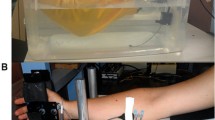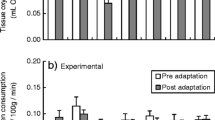Abstract
Cooling of a muscle has a detrimental effect on its force, power and contraction velocity, but may improve force control during precision movements by reducing physiological tremor. We investigated if the contractile characteristics of the first dorsal interosseus muscle (FDI) were linked to voluntary force control in warm and hypothermic conditions. Evoked peak twitch force, force at repetitive stimulation of 10 and 20 Hz, and submaximal force control at 25 and 50% maximal voluntary contraction (MVC) of the FDI were measured with cooled [mean (SD); 17.7 (1.3)°C] and warm [27.9 (2.3)°C] local skin temperatures in six males and four females. With evoked twitches, the time to peak tension was increased after cooling from 161 (38) ms to 219 (34) ms (P=0.001) and half-relaxation time increased from 94 (24) ms to 157 (46) ms (P=0.013). Peak force evoked from the repetitive stimulation contraction (10 Hz) increased significantly after cooling from 13.1 (10.2) N to 19.9 (12.1) N (P=0.026). The coefficient of variation (CV)—representative of the degree of fusion—for evoked repetitive stimulation force (10 Hz) was significantly higher in the warm [3.6 (2.7)%] versus hypothermic condition [2.2 (3.6)%] (P<0.05). At 25% and 50% MVC, there were no differences in the CV between warm and hypothermic conditions. FDI contractile characteristics change with local cooling, but have little effect upon voluntary submaximal isometric force control. Results are given as mean (SD).


Similar content being viewed by others
References
Bigland-Ritchie B, Thomas CK, Rice CL, Howarth JV, Woods JJ (1992) Muscle temperature, contractile speed, and motoneuron firing rates during human voluntary contractions. J Appl Physiol 73:2457–2461
CSEP (1998) Canadian Physical Activity Fitness and Lifestyle Appraisal. Canadian Society for Exercise Physiology
Davies CT, Mecrow IK, White MJ (1982) Contractile properties of the human triceps surae with some observations on the effects of temperature and exercise. Eur J Appl Physiol Occupl Physiol 49:255–269
De Ruiter CJ, Jones DA, Sargeant AJ, De Haan A (1999) Temperature effect on the rates of isometric force development and relaxation in the fresh and fatigued human adductor pollicis muscle. Exp Physiol 84:1137–1150
Lakie M, Walsh EG, Arblaster LA, Villagra F, Roberts RC (1994) Limb temperature and human tremors. J Neurol Neurosurg Psychiatry 57:35–42
Lakie M, Villagra F, Bowman I, Wilby R (1995) Shooting performance is related to forearm temperature and hand tremor size. J Sports Sci 13:313–320
Morton R, Provins KA (1960) Finger numbness after acute local exposure to cold. J Appl Physiol 15:149–154
Ranatunga KW, Sharpe B, Turnbull B (1987) Contractions of a human skeletal muscle at different temperatures. J Physiol (Lond) 390:383–395
Suzuki H, Conwit RA, Stashuk D, Santarsiero L, Metter EJ (2002) Relationships between surface-detected EMG signals and motor unit activation. Med Sci Sports Exerc 34:1509–1517
Tikuisis P, Keefe AA, Keillor J, Grant S, Johnson RF (2002) Investigation of rifle marksmanship on simulated targets during thermal discomfort. Aviat Space Environ Med 73:1176–1183
Acknowledgements
The authors would like to thank Cynthia Babineau for her technical assistance. This study was supported by the Natural Sciences and Engineering Research Council (NSERC) Discovery Grant. C. Geurts was supported by a NSERC PG-B Scholarship. This is original work that has not been previously submitted elsewhere and our experiments comply with Canadian laws.
Author information
Authors and Affiliations
Corresponding author
Rights and permissions
About this article
Cite this article
Geurts, C., Sleivert, G.G. & Cheung, S.S. Temperature effects on the contractile characteristics and sub-maximal voluntary isometric force production of the first dorsal interosseus muscle. Eur J Appl Physiol 91, 41–45 (2004). https://doi.org/10.1007/s00421-003-0938-8
Accepted:
Published:
Issue Date:
DOI: https://doi.org/10.1007/s00421-003-0938-8




